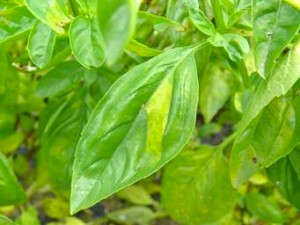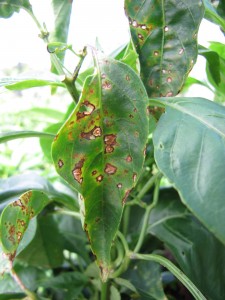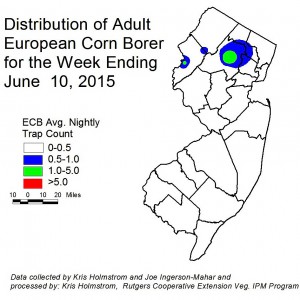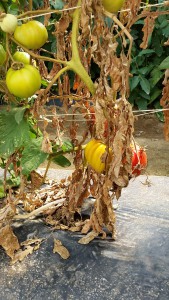This week:
Sweet Basil – Basil downy mildew
Bell Pepper – Bacterial leaf spot
Vegetable Crops Edition
Seasonal updates and alerts on insects, diseases, and weeds impacting vegetable crops. New Jersey Commercial Vegetable Production Recommendations updates between annual publication issues are included.
Subscriptions are available via EMAIL and RSS.
Quick Links:
 NJ Commercial Vegetable Production Recommendations
NJ Commercial Vegetable Production Recommendations
 Rutgers Weather Forecasting - Meteorological Information important to commercial agriculture.
Rutgers Weather Forecasting - Meteorological Information important to commercial agriculture.
Vegetable Diseases of the Week – 6/14/15
Vegetable Disease Briefs 6-14-15
- Basil downy mildew has been reported in New Jersey. All growers should be scouting on a regular basis and applying protectant fungicides.
- Late blight was reported on potato in northern North Carolina near the Virginia border on this past week. There have been no reports of late blight in the region to date. To track late blight in the US please visit http://usablight.org/
- Cucurbit downy mildew has been reported on cucumber, butternut, acorn, and yellow summer squash as far north as central South Carolina. To track the progress of CDM in the US please visit http://cdm.ipmpipe.org/
- The first reports of bacterial leaf spot are coming in on pepper and tomato.
- Black leg has been reported in potato in southern New Jersey.
Veg IPM Update: Week Ending 6/10/15
Sweet Corn
Catches of European corn borer (ECB) are now in decline through much of the state. Remaining areas of highest activity include parts of Morris and Warren counties (see ECB map).
ECB infestations are now rising in sweet corn plantings. Feeding ranges from single digits to 12% in areas where IPM personnel are operating.
Veg IPM Update: Week Ending 6/3/15
Sweet Corn
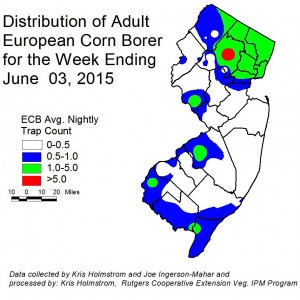 Cold temperatures and rain this week have prevented catches of European corn borer (ECB) from rising, and much of the activity represented in the map occurred over the weekend. Areas of highest activity include parts of Hunterdon, Morris and Burlington counties (see ECB map). Low level ECB infestations are present in early sweet corn plantings, and will become more significant with the return of drier weather.
Cold temperatures and rain this week have prevented catches of European corn borer (ECB) from rising, and much of the activity represented in the map occurred over the weekend. Areas of highest activity include parts of Hunterdon, Morris and Burlington counties (see ECB map). Low level ECB infestations are present in early sweet corn plantings, and will become more significant with the return of drier weather.
[Read more…]
Basil Downy Mildew Reported: Southern New Jersey – 6/3/15
Basil downy mildew (Peronospora belbahrii) has been found in a field near Vineland, New Jersey. This is the first report of downy mildew in field-grown basil in New Jersey this year. All basil growers need to scout on a daily basis and initiate a preventative fungicide program.
White Mold in Greenhouse & High Tunnel Tomato
White mold, or timber rot, caused by the soil-borne fungal pathogen, Sclerotinia sclerotiorum, was found this past week in a high tunnel.
White mold is common and once introduced into a field or high tunnel it can very difficult to control. The pathogen produces black sclerotia on the surface and inside infected stems. Sclerotia, if they make their way back into the soil, can survive for years causing significant problems.
Infected stems will turn a light brown color and dry up becoming brittle. If the main stem is infected the entire plant will collapse looking like a wilt or root rot issue.
Under hot, humid conditions white fungal growth will develop on the surface of the stems and in some cases sclerotia will develop on the outside of the stem. Breaking open the stem will reveal numerous black sclerotia.
All infected plants and or plant material need to be removed from the greenhouse or high tunnel immediately and disposed of properly. Preventative protectant fungicide programs beginning at flowering will help control white mold. Cool, wet weather and poor air circulation favors disease development.
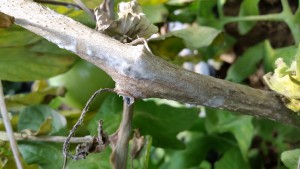
Tomato stem infected by white hold. Note the fungal growth on the surface of the stem.
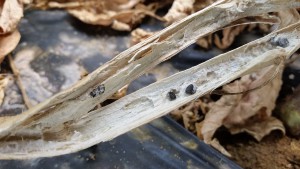
White mold of tomato. Note the black sclerotia developing inside the brittle stems.
